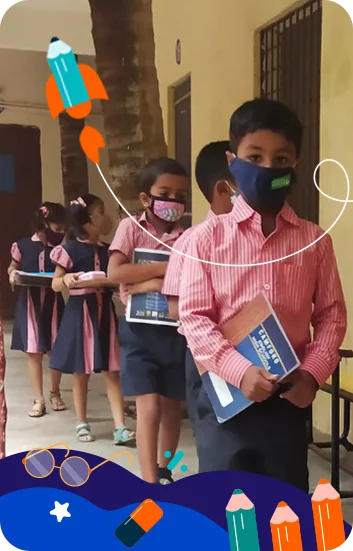Blended learning in schools ensures minimal interruptions

Give Your School The Lead Advantage
Learning beyond a 4-walled classroom was not real until the pandemic upended lives and traditional schooling took a hit—online learning became the new reality, and schools became flexible in their approach. Technology-based learning was adopted to survive, but it showed extraordinary results in student learning—owing to this success, technology became more than just an interim shift and now resides at the core of the sector. One of the major benefits of implementing technology in schools is that it ensures blended learning. But, what does blended learning in schools mean? Let’s have a look.
Blended learning is a teaching and learning approach that combines face-to-face learning with technology-mediated activities to deliver instruction. This pedagogical approach provides an optimal possibility of effective learning. The ongoing uncertainty has made the school owners doubt the existing traditional learning mode and have compelled them to shift to a more reliable learning model that allows them to shift between online and offline mode whenever required. The blended learning approach has created a fusion of self-learning and support-based learning as the teachers can guide the students as and when needed. As a result, fast learners don’t have to wait to move ahead with lessons, and slow learners can absorb complex topics through online sources at their own pace multiple times.
Some of the major advantages of blended learning in schools are:
- Increased student engagement
- Enhanced teacher-student interaction
- Development of self-reliance among students
- Flexibility of learning at own pace
- Enhanced student learning outcomes
- Enhanced reputation of the school
- Flexible teaching environment
- More resources to teach from for student better understanding
- Better opportunities for experiential learning
Smart classrooms are the new normal for new-age schools. These schools enable blended learning and allow the stakeholders to run a school in any mode—online, offline or both while ensuring minimum learning loss. This model also empowers teachers with tech-based teaching solutions that simplify teaching and allow students to learn better.
According to a report by UNESCO, “It is becoming increasingly vital for such smart learning environments (SLE) to be implemented in secondary and tertiary learning institutions, in order to ensure that learners are provided with the best learning experience possible that is not diminished by an outdated and irrelevant learning environment.”
How LEAD empowers teachers with its blended approach
Since the COVID-19 virus is here to stay, it will mean that certain parts of the country will repeatedly go into lockdowns of shorter duration whenever necessary. Schools need to make robust strategies and plans to operate in the post-lockdown world successfully. LEAD-powered schools impart a high standard of learning to their students. Bringing technology to online and offline classrooms,
LEAD has helped enhance its partner schools‘ performance and learning outcomes. The inclusive technology and integrated systems enhance schools’ efficiency by streamlining numerous academic functions, including coordination with teachers and parents. LEAD has also designed dedicated apps for parents and students, teachers, and school owners to assist them with the latest information, updates, and trackers. LEAD understands that teachers can do wonders with the right support, tools and techniques and a blended learning model. LEAD provides a fully-loaded tablet to every teacher in a LEAD that contains 100% ready-made teaching materials, from worksheets and assessments to homework plans and lesson plans across all topics.
LEAD is transforming schools by making children future-ready. To make yours a LEAD Powered School: Partner with us today



.jpg)


